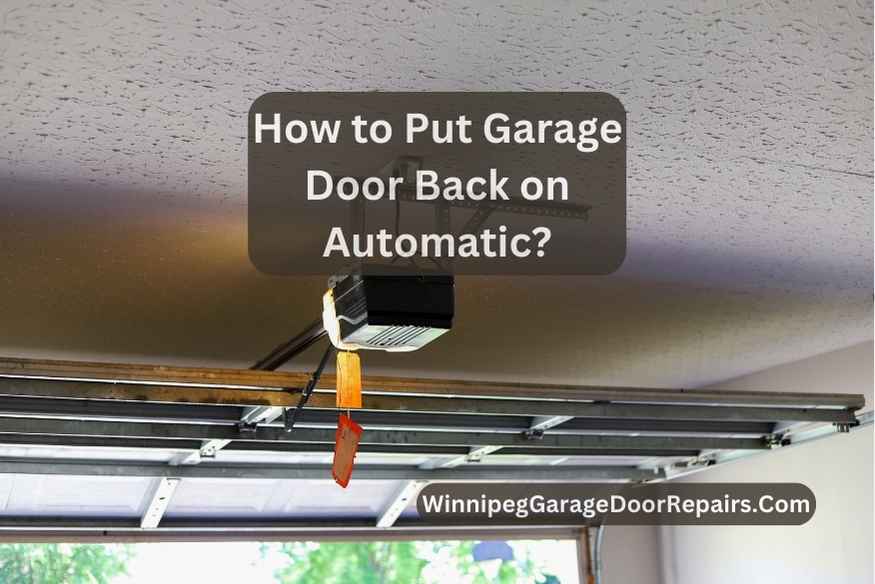Struggling with a garage door in Winnipeg that won’t go automatic? It’s a common challenge, but there’s a straightforward solution. Our guide, tailored for door repair Winnipeg, will walk you through reconnecting your garage door to its automatic opener. From locating the emergency release cord to testing the opener, we’ve got you covered. Ready to tackle this Winnipeg door repair task? Let’s dive in!
Quick Steps to Put Garage Door Back on Automatic
When your garage door won’t work automatically, it can be a hassle. This guide will show you how to fix it quickly and safely.

1. Locating the Emergency Release Cord
The emergency release cord is an essential feature of your garage door system, usually marked by its red color and hanging from the trolley mechanism. This cord plays a crucial role in situations where you need to switch to manual operation, such as during power outages or when the automatic opener malfunctions.
To locate it, look for the red cord hanging from a lever attached to the garage door track. This lever is connected to the trolley, which in turn is linked to the opener. It’s important to familiarize yourself with its location and function.
Knowing how to quickly find and use the emergency release cord can save time and prevent frustration during unexpected situations. It’s a simple yet vital part of maintaining control over your garage door’s functionality.
Must Read:- Chamberlain Garage Door Opener Battery Beeping
2. Disengaging the Door from the Opener
Disengaging your garage door from the opener is a straightforward process but requires careful attention. Once you’ve located the emergency release cord, pull it down with a firm, steady motion. This action releases the door from the connected trolley, allowing it to move independently of the automatic opener.
It’s a critical step when the power is out or if the opener isn’t functioning correctly. When you pull the cord, the lever attached to it disengages the trolley through a spring mechanism, which in turn releases the door.
This manual disengagement is a safety feature designed to ensure that you can still operate your garage door under any circumstances. It’s particularly useful during emergencies or maintenance work. Remember, once the door is disengaged, it will need to be operated manually, so ensure that it’s safe to do so before proceeding.
3. Manually Opening the Door
Manually opening your garage door can seem daunting, especially if it’s a heavy door. However, it’s manageable with the right technique. After disengaging the door from the opener, stand in the center of the door, grasp the handle or the bottom edge firmly, and lift upwards.
It’s important to lift with your legs, not your back, to avoid strain or injury. If the door is properly balanced, it should lift smoothly with minimal effort. If you encounter resistance or if the door feels excessively heavy, it could indicate an issue with the springs or the door’s alignment. In such cases, it’s advisable to seek professional assistance.
Manually opening the door should only be done when necessary, such as during a power outage or when performing maintenance. Always ensure that the area around the door is clear of obstacles and that the door is safe to move.
4. Manually Closing the Door
Once your garage door is open, you’ll need to close it manually. This process is similar to opening but requires a controlled, steady descent of the door. Start by grasping the handle or the bottom edge of the door.
Gently lower the door to the ground, guiding it straight down the tracks. Be cautious and avoid letting the door drop suddenly, as this can damage the door or cause injury. If the door is well-maintained and the tracks are aligned, it should glide smoothly without much resistance.
If you feel the door is too heavy or if it’s not closing evenly, stop and seek professional help. It’s important to ensure that the door closes completely to maintain security and protect against weather elements.
Regular maintenance of your garage door, including lubricating the tracks and checking the alignment, can make manual operation easier when necessary.
5. Re-engaging the Door with the Opener
After manually operating your garage door, re-engaging it with the automatic opener is a key step to return to normal functionality. To do this, locate the emergency release cord again. Pull it towards the direction of the motor unit, usually located at the center of the garage ceiling.
This action re-engages the trolley to the opener’s track. You might hear a clicking sound or see the trolley latch back into place, indicating successful re-engagement. It’s important to ensure that the door is properly aligned and balanced before re-engaging.
If the door is misaligned, it can cause issues with automatic operation. Once re-engaged, the door should be able to move smoothly along the tracks with the opener’s assistance. If you encounter any difficulties during this process or if the door doesn’t operate correctly afterward, it’s advisable to consult a professional technician for assistance.
Must Read:- How to Repair Garage Door Frame?
6. Testing the Opener
Testing the opener after re-engaging the garage door ensures that everything is functioning correctly. Use the remote control or the wall switch to activate the opener. The door should respond by opening and closing smoothly.
During this test, observe the door’s movement. It should not jerk or stutter, and there should be no unusual noises. If the door reverses direction unexpectedly or doesn’t fully open or close, it may require further adjustments. These could include realigning the sensors, adjusting the tension in the springs, or recalibrating the opener’s settings.
Regular testing of the garage door opener is an important part of maintenance. It helps identify potential issues early, ensuring the longevity and safety of your garage door system. If you’re not comfortable making these adjustments or if the opener still isn’t working correctly after your attempts, it’s best to call a professional for a thorough inspection and repair.
7. Safety and Professional Assistance
Dealing with garage doors involves certain risks, particularly when it comes to handling heavy doors or working with electrical components. Safety should always be your top priority.
If at any point during the process of putting your garage door back on automatic, you feel unsure or encounter a problem, don’t hesitate to seek professional help. A qualified garage door technician has the expertise and tools to safely and efficiently resolve any issues.
They can also provide valuable advice on maintenance and proper operation to prevent future problems. Additionally, regular professional inspections can help ensure that your garage door system remains in good working order and safe to use.
Remember, attempting repairs beyond your comfort level or expertise can lead to accidents or further damage to the door. When in doubt, calling a professional is the safest and most effective option.
Conclusion
You’ve now mastered the art of switching your garage door back to automatic. Remember, while these steps are simple, safety is key. If you encounter any issues or feel uncertain, don’t hesitate to call a professional. Regular maintenance and safety checks are essential for a smoothly functioning garage door. Keep this guide handy for any future garage door hiccups!







